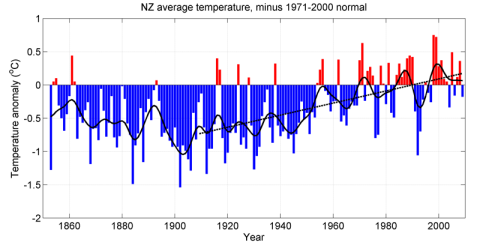NIWA has posted its NZ ‘seven-station’ temperature series data for download here. The best-fit linear trend over the past 100 years (1909 to 2008) shows NZ’s average annual temperature has increased by 0.9°C. A schedule of adjustments required to create this series is also available from this page.

Locations in the "seven station" series
The series has been derived from seven locations:
- Auckland
- Masterton
- Wellington
- Hokitika
- Nelson
- Lincoln
- Dunedin
These locations were chosen because they provide broad geographical coverage and long records (with measurements started at all sites by 1908)
Each location uses combined records from a few sites, because no single location has temperature records spanning from the 19th century to the present day. Because of this careful adjustments are required for the different sites. For example, the longest record in the country comes from Dunedin, with climate readings taken at six sites throughout its history. Learn more about why climate data sometimes need to be adjusted.
The adjusted data
This spreadsheet contains the adjusted data used to compile the 'seven-station' series. In this file, you will find:
- Annual average temperature for each location, and for the 7 locations combined
- Annual anomaly (difference from the 1971-2000 average) for each location, and for the 7 locations combined
The climatology (1971-2000 average temperature) in this series is specific to the “reference” stations used at each of the seven locations. These are:
- Mangere
- East Taratahi
- Kelburn
- Hokitika Aero
- Appleby
- Lincoln Broadfield
- Musselburgh.
If a different choice of reference site were made, then the climatology would change. For example, replacing Kelburn with Thorndon would increase the national-average temperature. However, this change would be applied to the whole Wellington record, and so the anomalies and trends would remain the same. The whole series would have merely been displaced by the same amount.
If stations are missing (e.g. Masteron prior to 1906) then the seven station combined value is calculated by:
- Calculating the annual anomaly for each location, and then use the average over all the locations available for that year. This prevents a missing year at a warmer site skewing the results.
- To create a national temperature record, we add this anomaly to the mean national temperature (12.58°C) as from the seven-stations during the reference period (1971-2000)
Changes - technical notes
The spreadsheet has been updated since first posted, to correct a historical data entry error for one location for a month in 1910.
A number of other changes have been made in the climate database:
- Digitising small amounts of data from early last century previously held in paper records in Wellington and Nelson
- Creating two station numbers for Hokitika to reflect the fact there were two sites
Full technical notes are here.
Schedule of adjustments
NIWA has documented all the station offsets used to merge temperature records from different sites at the 7 locations. This is often referred to as a "schedule of adjustments") and can be downloaded here.
Documentation of the adjustment process
As an example of the detailed application of the adjustment process, we have posted a ten page description of the adjustment process for the Hokitika site. We will be posting further descriptions for the other six stations in due course.
The 'seven-station' series was originally constructed by Dr Jim Salinger as part of his Ph.D. His thesis is held by Victoria University of Wellington, and the reference is:
- Salinger, M.J., 1981. New Zealand Climate: The instrumental record. Thesis submitted for the degree of Doctor of Philosophy at the Victoria University of Wellington, January 1981.
The methodology for adjusting for site changes in the NZ temperature record was published in the peer-reviewed International Journal of Climatology in 1993:
- Rhoades, D.A. and Salinger, M.J., 1993: Adjustment of temperature and rainfall records for site changes. Int. Journal of Climatology 13, 899 – 913.
The following is a selection of references to peer-reviewed scientific papers and other authorities outlining internationally accepted techniques for making adjustments to data to take account of changes such as movements of measurement sites:
- Della-Marta, P.M. and H. Wanner, 2006. A method for homogenising the extremes and mean of daily temperature measurements. Journal of Climate, 19, 4179-4197.
- Easterling, D.E. and Petersen, T.C, 1995. A new method for detecting undocumented discontinuities in climatological time series. Int. Journal of Climatology, 15, 369 – 377.
- Karl, T.R., and C.N. Williams Jr., 1987. An approach to adjusting climatological time series for discontinuous inhomogeneities. J. Climate Appl. Meteor., 26, 1744-1763.
- Kohler, M.A., 1949. Double-mass analysis for testing the consistency of records and for making adjustments. Bulletin American Meteorological Society, 30, 188-189.
- Vincent, L. A., Zhang, X., Bonsal, B. R., Hogg, W. D. 2002. Homogenization of daily temperatures over Canada. Journal of Climate, 15, 1322–1334.
- The methodology in the Karl and Williams (1987) paper is applied to the U.S. Historical Climatology Network maintained by NOAA.
- Section 4.8.3 on “Homogeneity of Data” in the “Third Edition of the Guide to Climatological Practices” published by the World Meteorological Organization’s Commission for Climatology.
Documentation of site changes
Information about site changes is in a publicly-available report published by the NZ Meteorological Service in 1992, and much of this information is also available from the metadata in NIWA’s climate database.
- Fouhy, E., Coutts, L., McGann, R., Collen, B., Salinger, M.J., 1992: South Pacific Historical Climate Network Climate Station Histories. Part 2, New Zealand and Offshore Islands. NZ Meteorological Service, Wellington. ISBN 0-477-01583-2.
